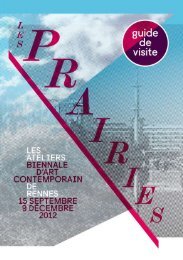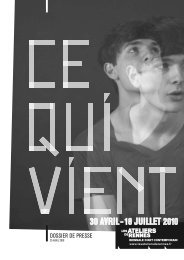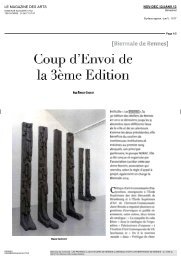Download here the Visitor's guide. - Les Ateliers de Rennes
Download here the Visitor's guide. - Les Ateliers de Rennes
Download here the Visitor's guide. - Les Ateliers de Rennes
You also want an ePaper? Increase the reach of your titles
YUMPU automatically turns print PDFs into web optimized ePapers that Google loves.
MARIE VOIGNIER<br />
Le Terrain était déjà occupé (le futur), 2012. Courtesy of <strong>the</strong> artist and galery Marcelle Alix, Paris.<br />
<strong>Les</strong> Prairies's artists<br />
Co-production<br />
<strong>Les</strong> <strong>Ateliers</strong> <strong>de</strong> <strong>Rennes</strong> 2012,<br />
Frac Bretagne.<br />
The subjects of Marie Voignier's vi<strong>de</strong>os are as varied as <strong>the</strong>y are rooted in reality – an abandoned<br />
wild-west <strong>the</strong>me park, an artificial tropical beach in former East Germany, or a bird migration<br />
phenomenon that <strong>de</strong>stroys crops are typical examples. In her sober style she switches registers easily<br />
from <strong>the</strong> fictional to <strong>the</strong> documentary to <strong>the</strong> cinematographic, thus un<strong>de</strong>rlining <strong>the</strong> reversibility of<br />
genres and point of view that can be applied to any one situation. She picks up different aspects of an<br />
event and brings out what is strange and absurd in it by simply representing it – <strong>the</strong> films reveal what<br />
lies un<strong>de</strong>rneath <strong>the</strong> surface realism. For <strong>the</strong> <strong>Ateliers</strong> <strong>de</strong> <strong>Rennes</strong> 2012, and in keeping with <strong>the</strong> spirit of<br />
<strong>Les</strong> Prairies, Marie Voignier has put herself in a real-life situation, that of looking at a building plot<br />
and investigating <strong>the</strong> different ways of approaching construction on it. A surveyor, a town-planner and<br />
a landscape architect take it in turns to express <strong>the</strong>ir vision and to explain <strong>the</strong>ir activity, and in doing so<br />
give <strong>the</strong> lie to <strong>the</strong> perception of <strong>the</strong> plot as a mere expanse of terrain. For this vi<strong>de</strong>o Marie Voignier drew<br />
inspiration from <strong>the</strong> television documentaries about architecture that Eric Rohmer ma<strong>de</strong> with Jean-Paul<br />
Pigeat in <strong>the</strong> 1970s. These films, inci<strong>de</strong>ntally, were an essential source for this curator in creating <strong>the</strong><br />
artistic project of <strong>Les</strong> Prairies. Forty years on, t<strong>here</strong> has been a noticeable change in attitu<strong>de</strong>s towards<br />
unbuilt-on land, whe<strong>the</strong>r it is meadow, field or wasteland. One is unlikely now to see someone stand<br />
in front of a huge field and say, as one of <strong>the</strong> architects in <strong>the</strong> Rohmer film does, "Look, t<strong>here</strong>, t<strong>here</strong> is<br />
nothing". The behol<strong>de</strong>r can reappraise his or her perception of built reality.<br />
A. B. tr. J.H.<br />
Born in 1974 in Ris-Orangis (France), lives and works in Paris (France).<br />
75






